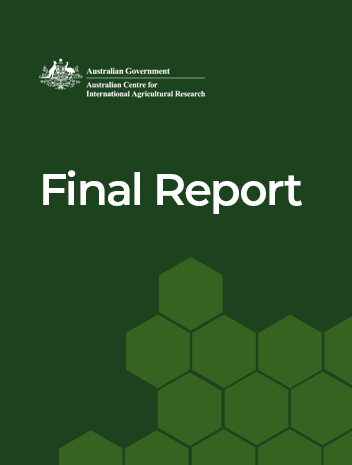- HomeHome
-
About ACIAR
- Our work
- Our people
-
Corporate information
- ACIAR Audit Committee
- Commission for International Agricultural Research
- Policy Advisory Council
- Agency reviews
- Executive remuneration disclosure
- Freedom of information (FOI)
- Gifts and benefits register
- Information publication scheme
- List of new agency files
- Contracts
- Legal services expenditure
- Privacy impact assessment register
- Commonwealth Child Safe Framework
- Benefits to Australia
- Careers
- 40 years of ACIAR
-
What we do
- Programs
- Cross-cutting areas
- Resources
- Where we work
-
Funding
- Research projects
- Fellowships
-
Scholarships
- John Allwright FellowshipScholarships to study in Australia for ACIAR partner country scientists to have Australian postgraduate qualifications
- ACIAR Pacific Agriculture Scholarships and Support and Climate Resilience Program
- Alumni Research Support Facility
- Publications
- News and Outreach
Project final report
Intercropping for intensification and diversification in the Indo Gangetic Plains - Final Report
Date released
07 August 2023
ISBN
978-1-922983-45-9
Publication Code
FR2023-040
Overview
This Small Research Activity (SRA) was established to investigate the potential for a full project on wide-row, additive intercropping in South Asia.
The project sought to determine (i) the agronomic potential for wide-row, additive intercropping in the Indo Gangetic Plain, (ii) smallholder farmers’ interest in and perceptions of this regionally-innovative intercropping, including any concerns and research challenges identified, and (iii) to plan a research agenda for a larger intercropping project.
The early research into wide-row, additive intercropping conducted in this SRA suggests that the practice is of strong interest to farmers, providing many with opportunities to increase the efficiency of their dry season cropping systems, and not only increasing cash flow in the dry season but also spacing out the timing of income. The research has demonstrated the feasibility of wide-row, additive intercropping as a strategy for sustainable and resilient farming systems intensification and diversification in the Indo Gangetic Plain.
In the general farming community, there is widespread awareness of intercropping in general, but little understanding of additive intercropping specifically. Farmers generally perceive there may be some benefits to the practice, but there is consistently an approximately 20 % difference in the understanding of the benefits and nuances of intercropping between those who have and have not undertaken intercropping recently. The farmers who participated in the SRA field trials were interested in wide-row, additive intercropping, and in accessing additional information regarding optimal agronomic management and value chain intervention points to enable farmers to successfully intercrop in their maize crops.
The SRA has recommended that the larger intercropping project examine wide-row, additive intercropping for maize and sugarcane main crops, and across a range of agroecologies and countries within the Indo Gangetic Plain within a research agenda along 6 key points:
- Participatory engagement with rural households;
- Agronomic trials (both on stations and on farmers’ fields);
- Understanding the effects of intercropping on household nutrition;
- Understanding the effects of intercropping on women’s empowerment;
- Value chain opportunities for smallholder farmers; and
- Scaling research for effective dissemination and to maximise the effectiveness of donor funding.



